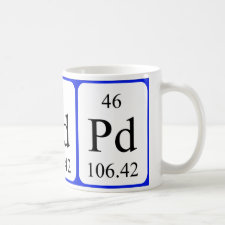
Authors: Daniel S, Babu PEJ, Rao TP
Article Title: Preconcentrative separation of palladium(II) using palladium(II) ion-imprinted polymer particles formed with different quinoline derivatives and evaluation of binding parameters based on adsorption isotherm models.
Publication date: 2005
Journal: Talanta
Volume: 65
Issue: (2)
Page numbers: 441-452.
DOI: 10.1016/j.talanta.2004.06.024
Abstract: Palladium(II) ion-imprinted polymer (IIP) materials were synthesized by thermally polymerizing the ternary complexes of palladium(II) with amino (AQ) or hydroxy (HQ) or mercapto (MQ) derivatives of quinoline and 4-vinyl-pyridine. The functional and crosslinking monomers used during polymerization were 2-hydroxyethyl methacrylate (HEMA) and ethylene glycol dimethacrylate (EGDMA). 2,2'-Azobisisobutyronitrile (AIBN) and 2-methoxy ethanol were used as the initiator and porogen, respectively. The resulting polymer materials were dried in an oven at 80 [deg]C, ground and sieved to obtain IIP particles which were then subjected to leaching with 50% (v/v) HCl to obtain the leached palladium(II) IIP particles. Control polymer (CP) particles were also prepared by following the above procedure described for IIP particles. The CP particles, unleached and leached AQ-based IIP particles were then characterized by IR, XRD and microanalysis studies. Analytical studies such as preconcentration of palladium(II) from dilute aqueous solutions and separation studies in the presence of selected noble and base metals which co-exist with palladium(II) in its ore or mineral deposits were systematically studied using CP and IIP particles and are compared. AQ-based IIP particles gave higher percent extraction and selectivity coefficients compared to HQ- or MQ-based IIP particles. Five replicate determinations of 25 μg of palladium(II) present in 500 ml of aqueous solution, when subjected to preconcentration and determination by iodide-Rhodamine 6G procedure gave a mean absorbance of 0.104 with a relative standard deviation of 2.25%. The detection limit corresponding to three times the standard deviation of the blank was found to be 5.0 μg of palladium(II) per litre. The rebinding studies using AQ-, HQ- and MQ-based IIPs were carried out and were fitted to the different adsorption isotherm models, viz. Langmuir (L), Freundlich (F) and Langmuir-Freundlich (LF). These adsorption models were used for the evaluation of binding parameters and in elucidating the nature and type of bonding in the IIPs. The results of rebinding experiments showed discrimination between the three IIPs based on the donor atoms of the ligands
Template and target information: palladium ion, Pd(II)
Author keywords: ion imprinting, Palladium(II), preconcentrative separation, adsorption isotherms



Join the Society for Molecular Imprinting

New items RSS feed
Sign-up for e-mail updates:
Choose between receiving an occasional newsletter or more frequent e-mail alerts.
Click here to go to the sign-up page.
Is your name elemental or peptidic? Enter your name and find out by clicking either of the buttons below!
Other products you may like:
 MIPdatabase
MIPdatabase









